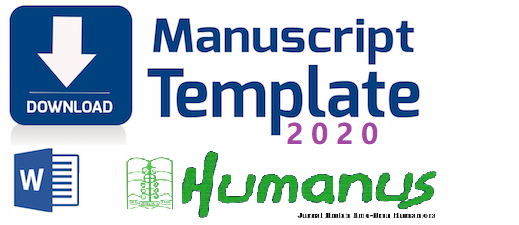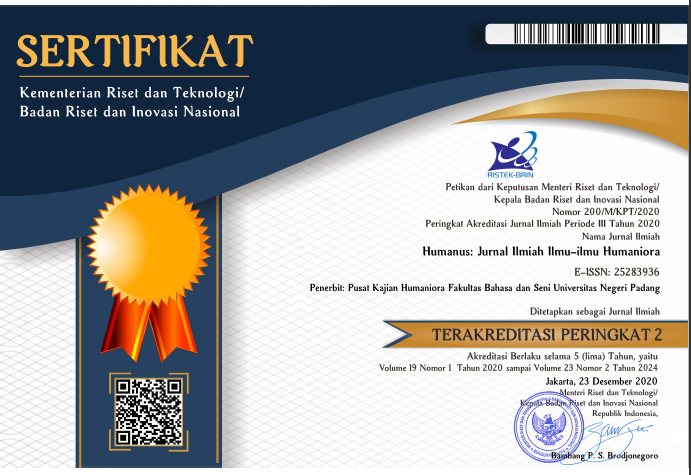How to Influence Others? Synthetic Personalization and Social Semiotic Analysis of Genders
 ), Erna Andriyanti(2), Ashadi Ashadi(3),
), Erna Andriyanti(2), Ashadi Ashadi(3), (1) Yogyakarta State University
(2) Yogyakarta State University
(3) Yogyakarta State University
 Corresponding Author
Corresponding Author
Copyright (c) 2023 Humanus: Jurnal Ilmiah Ilmu-ilmu Humaniora
DOI : https://doi.org/10.24036/humanus.v22i2.121129
Full Text:
 Language : en
Language : en
Abstract
Within the last 20 years, TED has become an influential platform that provides knowledge and education by directing speakers on giving motivational speeches. This paper aims to analyze gender attitudes while delivering the speech and how they influence the audience. This study applied a descriptive qualitative method by using Synthetic Personalization by Fairclough (2001) and a Social-semiotic approach by Van Leeuwen (2008) to the selected TED videos to analyze the data and corpus linguistics, namely AntConc, as the tool to analyze the vocabularies, first-person and second-person concordances presented. The findings show 1.101 vocabularies used by men and 1.156 vocabularies that denote synthetic personalization used by women. Although the strategies they used are different, men’s and women’s speeches have successfully influenced the audience by immersing synthetic personalization to bring intimate, engagement, and personal relationships towards the mass audience by bringing up the feeling of ‘similarity’. The social-semiotic covers social distance and social interaction between men and women toward the audiences. Women are more socially considerate while men are more direct in their speech. The distance and interactions are subjected as a form of representation of closeness.
Keywords
References
Anthony, L. (2014). AntConc ( Windows , Macintosh OS X , and Linux ) Getting Started ( No installation necessary ). 7, 3–4.
Baker, P., Gabrielatos, C., Khosravinik, M., Krzyzanowski, M., McEnery, T., & Wodak, R. (2008). A useful methodological synergy? Combining critical discourse analysis and corpus linguistics to examine discourses of refugees and asylum seekers in the UK press. Discourse and Society, 19(3), 273–306. https://doi.org/10.1177/0957926508088962
Borhani, M. (2019). Corpus analysis using relaxed conjugate gradient neural network training algorithm. Neural Processing Letters.
Cranny-Francis, A., Waring, W., Stavropoulos, P., & Kirkby, J. (2017). Gender studies: Terms and debates. Macmillan International Higher Education.
Djonov, E., & Van Leeuwen, T. (2018). Social media as semiotic technology and social practice: the case of ResearchGate’s design and its potential to transform social practice. Social Semiotics, 28(5), 641–664. https://doi.org/10.1080/10350330.2018.1504715
Fairclough, N. (2001). Critical discourse analysis. How to Analyse Talk in Institutional Settings: A Casebook of Methods, 2001, 25–38.
Fairclough, N. (2013a). Critical discourse analysis: The critical study of language. Routledge.
Fairclough, N. (2013b). Language and power. Routledge.
Holmes, J., & Wilson, N. (2017). An introduction to sociolinguistics. Routledge.
Kress, G., & Van Leeuwen, T. (2002). Colour as a semiotic mode: notes for a grammar of colour. Visual Communication, 1(3), 343–368.
Labov, W. (1972). The transformation of experience in narrative syntax. Language in the Inner City, 354–396.
Lakoff, R. (1973). Language and woman’s place. Language in Society, 2(1), 45–79.
Lu, K., Mardziel, P., Wu, F., Amancharla, P., & Datta, A. (2020). Gender bias in neural natural language processing. In Logic, Language, and Security (pp. 189–202). Springer.
Matwick, K., & Matwick, K. (2014). Storytelling and synthetic personalization in television cooking shows. Journal of Pragmatics, 71(September 2014), 151–159. https://doi.org/10.1016/j.pragma.2014.08.005
McEnery, T., & Hardie, A. (2011). Corpus linguistics: Method, theory and practice. Cambridge University Press.
Murphy, G. L. (1988). Personal reference in English. Language in Society, 17(3), 317–349.
Newman, M. L., Groom, C. J., Handelman, L. D., & Pennebaker, J. W. (2008). Gender differences in language use: An analysis of 14,000 text samples. Discourse Processes, 45(3), 211–236. https://doi.org/10.1080/01638530802073712
Özcan, F. H. (2016). Choice of address terms in conversational setting. International Journal of Human Sciences, 13(1), 982. https://doi.org/10.14687/ijhs.v13i1.3489
Page, R. (2012). The linguistics of self-branding and micro-celebrity in Twitter: The role of hashtags. Discourse and Communication, 6(2), 181–201. https://doi.org/10.1177/1750481312437441
Pilcher, J., & Whelehan, I. (2016). Key concepts in gender studies. Sage.
Putra, A. B., & Prayudha. (2020). The Analysis of Women and Men Language Features on America’s Got Talent. 2004, 1–9. http://eprints.uad.ac.id/id/eprint/14761
Rahimi, M., AMAL, S. E., & Deghat, S. (2010). The CDA of 2008 presidential campaign speeches of democratic candidates with respect to their gender & race.
Rustamov, D., Shakhabitdinova, S., Solijonovc, S., Mattiyev, A., Begaliyev, S., & Fayziev, S. (2021). Research of peculiarities of speech of male and female on phonetic and lexical levels of language. Journal of Language and Linguistic Studies, 17(1), 421–430. https://doi.org/10.52462/jlls.26
Subon, F. (2013). Gender Differences in the Use of Linguistic Forms in the Speech of Men and Women in the Malaysian Context. IOSR Journal Of Humanities And Social Science, 13(3), 67–79. https://doi.org/10.9790/0837-1336779
Van Dijk, T. A. (1993). Principles of critical discourse analysis. Discourse & Society, 4(2), 249–283.
Van Dijk, T. A. (2001). Critical discourse analysis. The Handbook of discourse analysis. Malden, Mass: Blackwell Publishers Ltd.
Van Dijk, T. A. (2005). Critical discourse analysis. The Handbook of Discourse Analysis, 349–371.
Van Leeuwen, T. (2008). Discourse and practice: New tools for critical discourse analysis. Oxford university press.
Van Leeuwen, T. (2014). Representing social actors. In Critical Discourse Analysis: Concepts, History, Theory (pp. 291–326). SAGE Publications.
Weirich, M., & Simpson, A. P. (2018). Gender identity is indexed and perceived in speech. PloS One, 13(12), e0209226.
Weiss, G., & Wodak, R. (2007). Critical discourse analysis. Springer.
Wodak, R. (2004). Critical discourse analysis. Qualitative Research Practice, 185, 185–204.
Wodak, R. (2005). Gender mainstreaming and the European Union: Interdisciplinarity, gender studies and CDA. In Feminist critical discourse analysis (pp. 90–113). Springer.
Wodak, R., & Fairclough, N. (2013). Critical discourse analysis. Sage Los Angeles.
Wong, W. W. B. (2016). Synthetic personalization of Barack Obama at the 2008 US Democratic National Convention: a social semiotic multimodal analysis of a staged political context. Visual Communication, 15(4), 509–534. https://doi.org/10.1177/1470357216632164
Xia, X. (2013). Gender differences in using language. Theory & Practice in Language Studies, 3(8).
 Article Metrics
Article Metrics
 Abstract Views : 229 times
Abstract Views : 229 times
 PDF Downloaded : 206 times
PDF Downloaded : 206 times
Refbacks
- There are currently no refbacks.
Copyright (c) 2023 Humanus: Jurnal Ilmiah Ilmu-ilmu Humaniora

This work is licensed under a Creative Commons Attribution-NonCommercial 4.0 International License.











